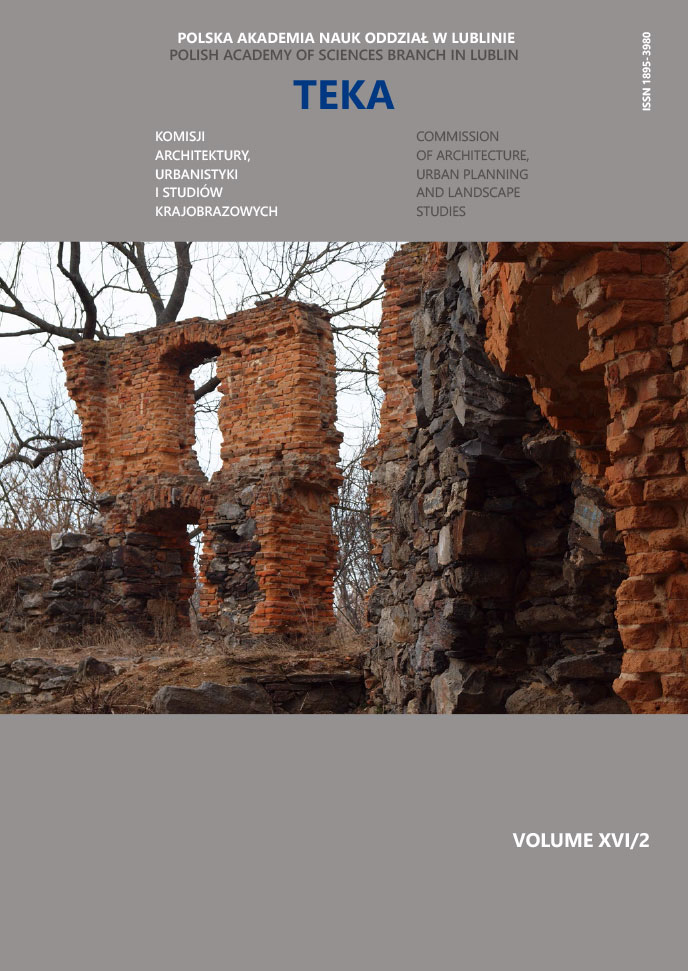Perception and functionality of space in view of potential and dysfunction of senses Sense-sensitive Architectural Design
Article Sidebar
Open full text
Issue Vol. 16 No. 2 (2020)
-
Perception and functionality of space in view of potential and dysfunction of senses
Sense-sensitive Architectural DesignAgata Gawlak, Magda Matuszewska, Agnieszka Ptak, Magdalena Priefer7-16 -
Nineteenth-century, non-existent buildings of the Castle Hill in Lublin
Krzysztof Janus17-25
-
Freehand drawing as a basic means of artistic expression in the process of educating future architects versus modern computer technology
Agnieszka Chęć-Małyszek26-36
-
The image of the spa town of Szczawno-Zdrój in light of the transformation of the city of Wałbrzych at the turn of the 20th and 21st centuries
Marek Piróg37-43
-
Contemporary architectural interventions in the historical tissue of Cádiz – contextual minimalism in the service of genius loci
Joanna Białkiewicz44-56
-
The Community House (Dom Ludowy) in Nałęczów as an example of social architecture of the early 20th century
Kamila Lucyna Boguszewska57-67
-
Architecture and typhlology. The potential of scientific partnership
Agnieszka Kłopotowska68-75
-
Use of laminated timber in the construction of high-rise buildings, on the example of implementations from western countries
Michał Dmitruk76-87
-
Zbór kalwiński w Piaskach – od ruiny do trwałej ruiny
Piotr Gleń88-93
-
Artistic painted decorations on the outside walls of the castles in western Ukraine
Mykola Bevz94-106
-
Revitalization of the city’s riverside areas on the example of the urstromtal of the Malczewski Stream in Radom
Margot Dudkiewicz, Marek Dąbski, Sylwester Kaczmarski107-112
Archives
-
Vol. 18 No. 4
2022-12-30 5
-
Vol. 18 No. 3
2022-12-27 5
-
Vol. 18 No. 2
2022-12-27 5
-
Vol. 18 No. 1
2022-12-27 4
-
Vol. 17 No. 4
2021-12-30 11
-
Vol. 17 No. 3
2021-12-30 9
-
Vol. 17 No. 2
2021-12-30 8
-
Vol. 17 No. 1
2021-12-30 8
-
Vol. 16 No. 4
2020-12-30 11
-
Vol. 16 No. 3
2020-09-30 10
-
Vol. 16 No. 2
2020-06-30 11
-
Vol. 16 No. 1
2020-03-31 10
-
Vol. 15 No. 4
2019-12-30 6
-
Vol. 15 No. 3
2019-10-31 9
-
Vol. 15 No. 2
2019-06-28 12
-
Vol. 15 No. 1
2019-03-29 13
-
Vol. 14 No. 3
2018-10-28 14
-
Vol. 14 No. 2
2018-06-29 14
-
Vol. 14 No. 1
2018-03-30 13
Main Article Content
DOI
Authors
magda.matuszewska@put.poznan.pl
Abstract
This article is of an illustrative nature. It is intended to juxtapose the possible options of architectural perception and the potential capabilities and dysfunctions of senses. It is, further, aimed at highlighting the co-dependence of the perception of architecture on mental and physical abilities of man (its observer and user).
The way space is perceived is dictated by the perceptual capabilities of our senses. Understanding the physiology and the role of the senses can sensitise the designers to the fact that the users’ responses to his/her works might diverge from the perceptual processes in the brain of the creator him/herself. More importantly, architecture itself can generate sensory feedback and exert a therapeutic effect in view of sensory dysfunctions.
Keywords:
References
Banasik-Petri K., Architektura zmysłowa – Nowe tendencje w procesie projektowania na podstawie wybranych przykładów z twórczości Kenya Hary, KNUV.
Buchanan A., i in., From Chance to Choice: Genetics & Justice, Cambridge University Press, 2000. DOI: https://doi.org/10.1017/CBO9780511806940
Davis, L. J., The disability studies reader. New York: Routledge, 2013. DOI: https://doi.org/10.4324/9780203077887
Day C., Places of the Soul. Architecture and Environmental Design as a Healing Art, Routledge, Londyn 2004.
Hall, E.T., Hidden Dimension, 1996.
Kłopotowska A. Niewidzialna architektura – status piękna w poza wzrokowej percepcji przestrzeni architektonicznej, Czasopismo Techniczne. Architektura, Wyd. Politechniki Krakowskiej, Kraków, 2007, R. 104, z. 6-A, s. 269-274.
Koestler A., The Act of Creation, Hutchinson & Co Ltd, Londyn 1964, s.158
Kusiak J., Świątkowska B. (red.), Miasto-Zdrój. Architektura i programowanie zmysłów, Fundacja Bęc Zmiana, Warszawa 2013.
Mitra S., The Capability Approach and Disability, “Journal of Disability Policy Studies”, 2006, t. 16, no. 4, p. 236-247. DOI: https://doi.org/10.1177/10442073060160040501
Muca K., Niepełnosprawność jako inność. Popularny dyskurs o braku sprawności w świetle kulturowych badań nad niepełnosprawnością. Perspektywy ponowoczesności. Tom 6. Ksenologie, 2018, s. 149-168.
Pallasmaa J. Oczy skóry. Architektura i zmysły, Wyd. Instytut Architektury, Kraków 2012.
Paszkowicz M. A., Niepełnosprawność w świetle koncepcji zorientowanej na ludzkie możliwości, “Prakseologia”, 2014, nr 156, s. 205-224.
Rasmussen S. E., Odczuwanie architektury, Wydawnictwo Murator, Warszawa 1999.
Sen, A. K., Development as freedom, Knopf, New York, 1999.
Spence C., Senses of place: architectural design for multisensory mind, Cogn. Research 5, 46, 2020. https://doi.org/10.1186/s41235-020-00243-4 [dostęp 28.10.2020]. DOI: https://doi.org/10.1186/s41235-020-00243-4
Wrona-Polańska H., Czerniawska E., Wrona L. (red.), Szkice o ludzkim poznawaniu i odczuwaniu, Wydawnictwo Naukowe Uniwersytetu Pedagogicznego, Kraków 2009.
Wyburn, G. M., Pickford R. W., Zmysły i odbiór wrażeń przez człowieka, Państwowe WydawnictwoNaukowe, Warszawa 1970.
Article Details
Abstract views: 453
License

This work is licensed under a Creative Commons Attribution-ShareAlike 4.0 International License.


